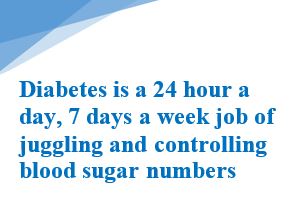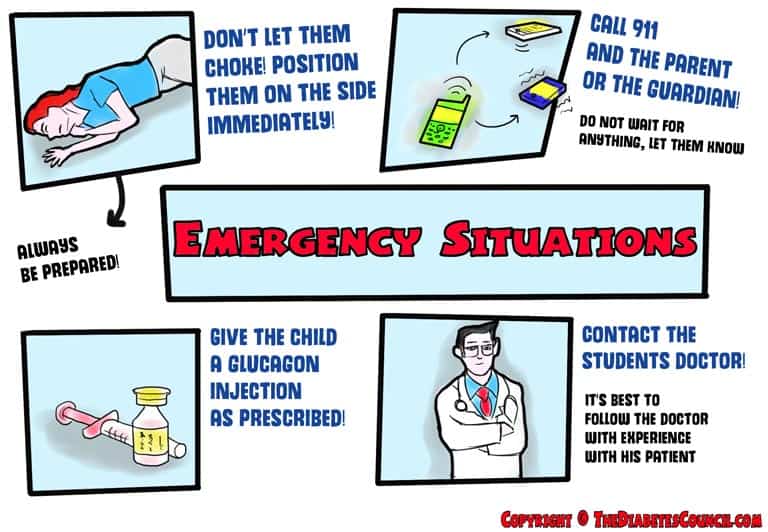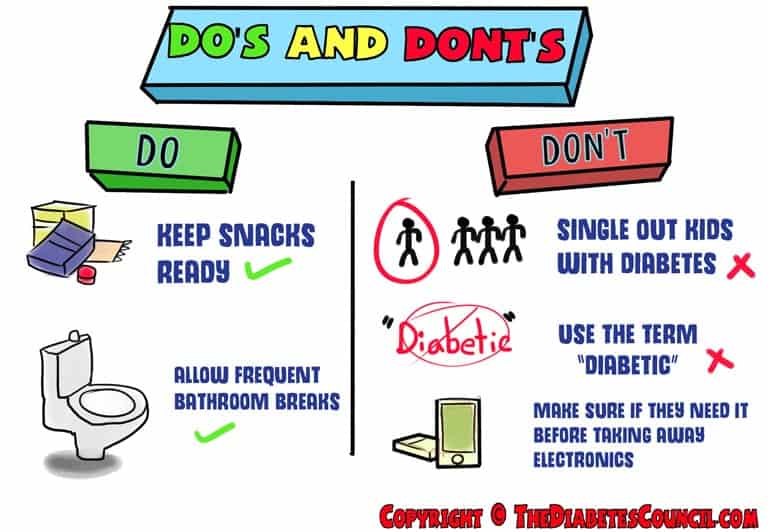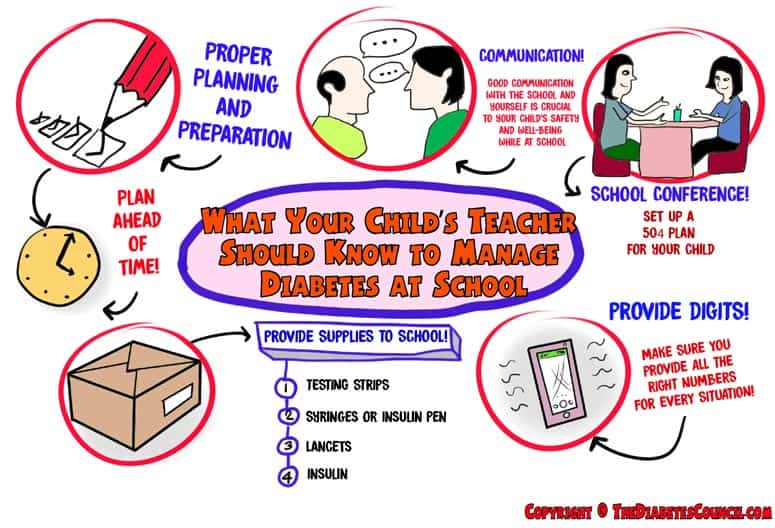
Whether your child has been newly diagnosed or has been living with type 1 diabetes for some time, it’s very challenging. Many parents find it difficult to trust someone other than themselves or family members with training to care for their children. But when school time arises it will be time to send them off to be monitored and cared for by someone else many hours out of the day. Entrusting the medical needs of your child to someone else will be hard, but it’s a necessary step in teaching them to be more independent and live a happy, social life despite having type 1 diabetes.
Contents
Parents Responsibilities for School
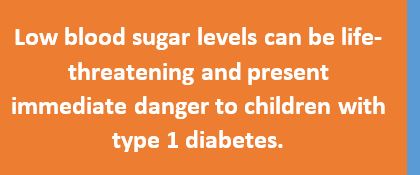
It is your job, as your child’s parent to help create an environment when they are at school where they feel safe, cared for properly and treated equally to other students. With the proper planning and preparation, you provide this environment with the help of their teachers and school staff. The first step is to take the initiative to educate staff and teachers on the care of a type 1 student. Many school staff members may not realize there are a few additional efforts which are required on their end to ensure a positive learning environment where the child with type 1 diabetes feels safe.
I advice reading the following:
Ensuring Success at School
Advanced planning: By making sure you plan ahead of time you will help to enable your child how to problem solve specific situations in school involving their diabetes. Here is a great tip: remember even with proper planning and a well-organized family, there will still be times when your plans don’t go according to plan.
Communication: Good communication with the school and yourself is crucial to your child’s safety and well-being while at school. It will also help to provide yourself with a peace of mind during this difficult transition of care.
Education is Important: Remember school is still a place of learning and education is an important part of their day for everyone. Because your child will have many self-care and health care needs that need attended to throughout the day, establishing a schedule for this with the school staff is vital to ensuring everyone still has access to education.
- Start by teaching your child as much about their diabetes as you can according to their age. Try to include any school specific types of situations for your child, so they understand who they should be going to for help and when.
- Provide the school nurse and teacher with supplies your child may need throughout the school day:
- Testing strips
- Syringes or Insulin Pen
- Lancets
- Ketodiastix
- Insulin
- Blood Glucose Meter
- Items to treat low blood sugars: Glucose tablets, juice boxes, candy, etc.
- Glucagon
- Travel sized sharps container to dispose of syringes and lancets properly.
- Provide the school staff with a list of phone numbers to be used in case of an emergency. This will include their parents phone numbers, and any alternate numbers. Include numbers to your child’s diabetes doctor or other team members in charge of their care.
- Plan for a conference at the beginning of the year prior to school starting to educate those who will be in contact with your child throughout their day.
School Conference
Before your child returns to school, you will need to initiate the scheduling of a school conference. This may include setting up a 504 plan for your child. NOTE: a 504 plan is a written agreement between you and the school that helps to plan out what accommodations the school will provide for your child.
New conferences should be scheduled when:
- It’s the beginning of a new school year
- Changing of school districts
- During the year if problems of controlling blood sugar levels arise
Participants May Include
- Parents
- School Nurse
- Teachers
- School Counselor
- Principal
Work with school staff at this conference to develop a care plan or DMMP (Diabetes Medical Management Plan). This plan will include scheduled times to check blood sugar, the symptoms of hyperglycemia and hypoglycemia, when snacks should be consumed and a detailed plan for an emergency.
Included in your care plan should be any action that the teacher and your child will follow if they experience a low blood sugar when in class.
TEACHERS: Remember to NEVER allow a child with Type 1 diabetes who is experiencing a low blood sugar walk to the nurse’s office alone. This is why it is vital to put into the child’s care plan that they must be accompanied by someone during these times.
A successful diabetes care plan is one that allows school staff to understand the plan is to help prevent any emergency situation from arising, and how to handle one should it occur.
Emergency Situations
In the event of a hypoglycemic emergency while at school, there should be a plan of action in place for school staff. A sample plan would include:
If the student cannot drink or eat anything or is unresponsive or experiencing seizures staff should:
- Position them on their side so that they will not choke
- Give the child a glucagon injection according to the doctors’ orders
- Call 911 and the parents and guardians
- Contact the students doctor
When the student experiences a hyperglycemic emergency, staff should call 911 and contact the child’s parent / guardians. Teachers and school staff should also be aware that periods of hyperglycemia may require additional trips to the bathroom. This can be included in your child’s DMMP or 504 plan.
Communication
It’s vital to your child’s educational success to establish a direct line of communication with all school staff members in charge of your child’s care. You can decide ahead of time if you need to communicate with each other daily, weekly or just as the need arises.
What Teachers Need to Know
Being an educator in the school system not only comes with the responsibility of having to care for upwards of 20 to 30 children each day, but during this time you may also be responsible for a student who has type 1 diabetes. While you may feel overwhelmed and concerned about what you should expect, there really isn’t any need to. This comprehensive guide will help provide you with pertinent information on how to be aware of the various conditions for a child with type 1 diabetes. Through this guide you will gain a better understanding of what you should do to help keep them safe and healthy when they are at school.
What is Type 1 Diabetes?
This is one of the most confusing things for many people, they assume because of the name, type 1 diabetes is similar to that of type 2 diabetes. Well, in many ways they are similar but unlike type 2, type 1 diabetes is an autoimmune disorder that happens when the body’s immune system begins destroying the cells, called beta cells which are responsible for producing insulin in the pancreas. Those with type 1 diabetes are dependent on insulin for the rest of their life. They must get this insulin through many daily injections or the use of an insulin pump.
They then must balance their insulin with exercise, food and many other factors to prevent both short and long-term complications.
If you are not really familiar with type 1 diabetes, I’d like to give you a few facts to help.
- Type 1 diabetes isn’t caused by a poor diet or lack of exercise.
- It is not contagious
- There currently is no CURE for type 1 diabetes; insulin is a treatment
- While type 1 diabetes in the past used to be known as juvenile diabetes, it now is understood to affect both adults and children.
- Children do not OUTGROW type 1 diabetes
What Questions Teachers Should Ask Parents?
Parents of children with type 1 diabetes offer a wealth of knowledge and information in regards to their child’s medical care.
They provide care for them 24/7 while at home with no breaks even during the holidays or weekends. Because of this they understand the stress of caring for a child with a chronic illness and can offer teachers help in caring for their child.
Additionally, it’s important for teachers to understand the fears that many parents may have in sending their child with type 1 to school. To help both teachers and parents, teachers should ask any questions they may have to parents ahead of time. Some important questions to help both parties may include:
- What are the symptoms of a low/ high blood sugar with your child? (Each child is different)
- What happens after they participate in a physical activity such as gym or recess?
- What questions do you have that I may answer to ease your fears for the school year?
- What is the best way to contact you during the year?
- What behaviors do they exhibit when they are low or high? (i.e. not listening to directions, doing things off task, etc.)
- When would they be required to eat a snack in class?
- What affects your child’s blood sugar the most?
- How should I refer to their condition to your child? (Some children do not prefer to be called a diabetic, everyone is different)
Do’s and Don’ts for Teachers
When you have a student with type 1 diabetes and are unfamiliar with the condition, you might not know how to interact with your student so that you do not offend them. Here are some DO’s and Don’ts that will make this process much easier.
DON’T single out the child for having type 1 diabetes. It is challenging enough for them to have it, but when they are singled out in front of their peers, this can be embarrassing.
DO understand that they may require food in the classroom. Snacks can help to make sure their blood sugar levels do not drop while they are in class.
DON’T take away any electronics they may have before finding out if they are related to caring for their diabetes. Smartphones now are carried by students to monitor their blood sugar levels via a CGM.
DO learn to recognize that odd behaviors in class may require them to check their blood sugar immediately. Blood sugar levels can drop quickly so time is of the essence.
DON’T call the student a ‘diabetic’ unless they are okay with this term. Some children do not like being labeled as this makes them feel differently than the other students. They just want to be like everyone else.
DO realize that students with diabetes may need to use the bathroom more frequently while at school. This is usually a sign that they are experiencing a high blood sugar.
DON’T send them off alone or by themselves anywhere, especially when they tell you that they are low.
Advice from an Experienced Teacher
Recently, I reached out to my youngest child’s teacher with T1D about working as an educator and caring for a child with Type 1 diabetes while in the classroom. She shared with me some amazing advice for teachers who have never had this experience before.
Mrs. Lisa Treese is a Kindergarten teacher who also has a son with Type 1 diabetes herself.
What is the most challenging part of having a child with type 1 diabetes in your room?
I’m always worried about not catching signs for low blood sugars. Because each child is different, my students may not be the same as my sons, so it is really difficult at times.
How can you explain to other students in the classroom about their peer’s condition?
I have my student tell the other students in the class and show them everything they need to help with their diabetes. We then explain what they are why and when they are needed and how they can help. We talk about our body’s pancreas and how my student’s, my son’s and my student’s big brother (who has type 1 diabetes too) has a pancreas that doesn’t make insulin and how the other students do. When then talk about the differences in type 1 and type 2 diabetes because some of the student’s family members have type 2 so we discuss that as well.
In your experience how do you handle a low blood sugar in the classroom?
With the permission of the parent I call the nurse and give the student glucose tablets if they are able to chew.
Further reading:
What would you recommend to teachers who just found out that they will have their first student with Type 1 diabetes in class?
First, Relax! It’s not that difficult. Just remember that they have a lot of things to deal with and there may be times that you need to stay patient and keep an extra set of eyes on him/ her. When in doubt, check their blood sugar (with parental permission) and call the nurse. Talk to the parents regularly too, because they are so full of information about their child.
References:
TheDiabetesCouncil Article | Reviewed by Dr. Jerry Ramos MD on June 01, 2020



